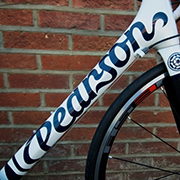
A box of frogs?
There’s a lot to be said about single speed bikes, and let’s face it there has been ever such a lot said. But one thing is for certain; direct chain driven transmission is incredibly mechanically efficient. There is almost no loss of effort between pedals and rear wheel when using two sprockets and a roller chain, resulting in the unsurpassable performance of a fixed wheeled bike like the Pearson Touché [that’s enough of a plug – ed.].
So why re-introduce a choice of gears to a machine that is already near perfect? As converts to fixed culture will testify, the advantages of riding a bike with a single gear and fixed wheel are numerous, well-proven and discussed at great length on blogs, forums and websites worldwide ( there seems a particularly strange crossover between fixed riding and blogging). Nationally across the UK single speed bike sales are huge, in a market dominated by the likes of the Specialized Langster and Pearson’s Touché .
Every type of bike must surely have its disadvantages and the fixed is no exception. Being locked into a single gear exposes the rider to altering terrain and conditions – over-geared to the point of labouring uphill or into a headwind, and then grossly under-geared whilst descending and forced into an unnaturally high cadence otherwise seen only in flailing agricultural machinery.
Double sided hubs allow the gear size to be changed in a minute or so by simply flipping the wheel and running the chain on a different sized sprocket. This type of hub is very common, although it often is fitted with a fixed on one side and a freewheel of the same size on the other. If this is what is wanted, would make more sense to provide the rider with the means to alter the size of the fixed gear en route, which is where the Sturmey Archer S3X comes in.
The Sturmey Archer hub gear has been in production for about a century in various forms but orignally and famously the standard with three ‘speeds’. This seasoned piece of equipment has appeared on a diverse range of machines, from racing bikes to your mum’s shopper and is the epitome of reliability and simplicity. The 3-speed fixed is a hybrid of the standard hub gear and was first produced in the late ‘40s, when fixed wheel riding was at a previous high.
The principle is the same as a normal hub except that the rider is unable to freewheel in any of the gears. It makes good sense to ride ‘fixed’ in a group, where an individual’s speed can be finely adjusted allowing club riders to enjoy the close proximity of other riders in a group, typically in winter months, and stay with the guys on derailleur gears. Just look at the control a pro trackie in the Madison event has when dropping back into line after a change, only an inch away from the next wheel while riding at full tilt.
The three gears of the S3X are changed by means of a lever on the end of the handlebar, and can offer the rider a gear size either side of a chosen ratio, i.e. one for climbing and one for descending each side of the ‘normal’ gear. It makes perfect sense but, like anything, it too has its drawbacks. If it is second that is used as the normal riding gear (for you purist types probably around 72”) then with the S3X there will be an element of that most terrible by product known to cyclists, drag (not cross dressing by the way).
This also goes for first gear, because only top or third gear offers one-to-one or ‘direct’ drive from the chain transmission to the rear wheel. Second and first are both reductions (-25% and -37.5% respectively) so energy is passed through a series of cogs, pinions and whatever else is in that box of frogs.
Nevertheless there’s not that much, and it would be soon forgotten by a rider who found life in one gear challenging. (The perfect answer would be to have the direct drive in second gear with a reduced gear as first and an increased gear as top, but I’m sure this is impossible.) [Er, no; the SRAM T3 has direct middle – ed.]
It has another slight fault in that there is a small amount of backlash in the pedalling action, about 15 degrees of no-man’s-land between the pedals driving the bike and the bike driving the pedals, engineered to an absolute minimum but noticeable nonetheless. This, unfortunately, is absolutely necessary to allow the gears to change at all and is certainly something a rider will get used to, however you do lose that seamless momentum carrying feeling over the top of the pedal stroke that makes fixed riding so addictive, so efficient and so very good for you, that may manifest as the sacred souplesse of the legs which will no doubt give the rider an advantage.
So the S3X may not be for the purist after all, but it would suit the commuter or club rider as a great addition to a beloved bike, making journeys and rides just a little more legs-friendly. Its good practical sense combines with a slightly mystical quality to have the makings of an enviable retro bike component.





